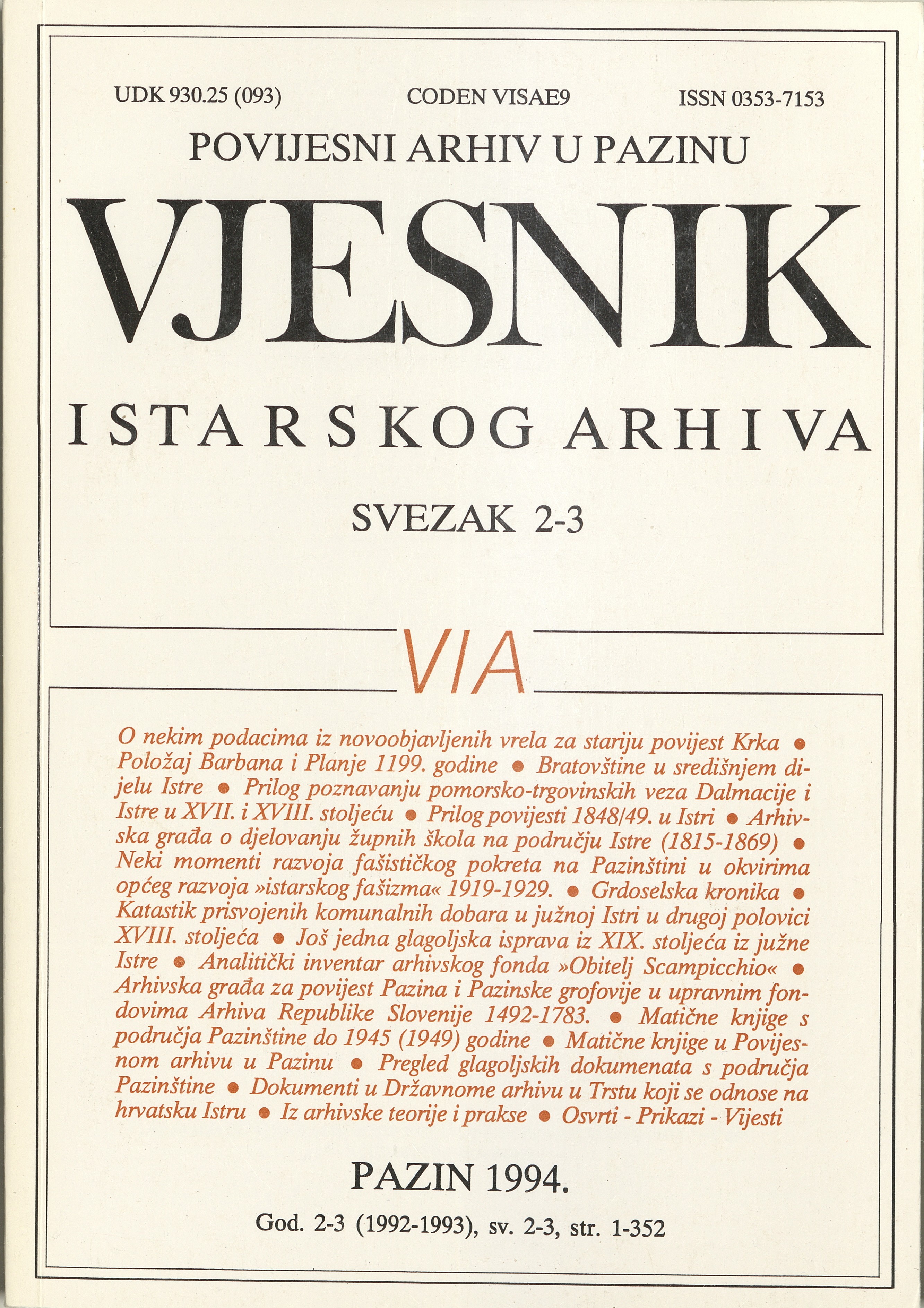Some moments in the development of the fascist movement in the Pazin region within the frames of the general development of the »istrian fascism« 1919-1929 (through commentaries of archiviste documents)
Abstract
On the basis of only a handful of documents from collections of the Historical Archive in Pazin and the State Archive in Trieste, the A tried to present a rapid review of the appearence and development of fascism and the fascist movement in the Pazin region. To make the particularities of this process more visible (the speed of development, the social, national and age structure, the basic political orientations within the movement), the general political outline is given, together with the particular conditions of the postwar Istrian political scene as one of the most important conditions for the appearance and development of Fascism in these regions. Only the basic elements of development processes are presented, and only so much as the used archival material »allowed« it, without any ambition for a complete review, but also not hiding the scope of presenting the role, or the participation of Fascism in the Pazin region in what historiography lately calls »provincial« Fascism - or, more explicitly, »Istrian Fascism«. It is extremely important to note that archive collections do not abound in useful documents which would give a global picture of events in the Pazin region: the material is fragmentary and only partly preserved. For this reason, it was necessary to present the development of Fascism in the Pazin region within the frames of the general development of Fascism in Istria and incorporate it in the wider notion of »Istrian Fascism«. Fascism in interior Istria (of which the Pazin region represents the biggest part) developed under very specific social and ethnic conditions. The Pazin region, inhabited predominantly by Croatian population (Italians lived mainly in urban environment), represented from the beginning the biggest obstacles to the development of Fascism. Therefore the participation of the community to Fascist organizations was the lowest. And the region would maintain that position throughout the duration of the Fascist regime. Although Fascism in the Pazin region passed through identical stages of development as in other parts of Istria, and although it was brought on by the same social strata (intellectuals, demobilized officers and soldiers of the Italian Army, veterans and volunteers, prewar irredentistic youth), it presents all typical features of »agrarian«, rural Fascism, which would later always be in opposition to the Fascist bureaucracy and »town petty politicians«. The appearance and development of Fascism and the Fascist movement, as well as its features inside the District, the Sub-Prefettura in Pazin, depended mainly on »internal« factors: ethno-national and social configuration, political and economic conditions of post-war Istrian society. Here, in interior Istria, the development of Fascism was somewhat slower than in other parts of the peninsula. The preponderant Croatian majority, living in strong patriarchal rural communities, was the main obstacle to a quick development of Fascist ideology, and then organization, which in Istria had a strong anti-Slav course. The infiltration of Fascism in these »allogenous - gray« zones was therefore possible only after the destruction of the national, cultural, spiritual, political and economic institutions of Istrian Croats in this region. The fact that Fascist organizations first made their appearence in bigger urban environments, and later on in the rural milieu of the Pazin region, speaks for itself. Fascism in the Pazin region, starting as a typical »urban« movement, acquires ever more an »agrarian« rural character towards the end of the 20-ies, changing not only its social but also national structure. This is one of the main features of the Fascist movement in the Pazin region. The »agrarian« fascism was not only in opposition to the »urban« movement within the never overcome national component, but it was also in antithesis to the »urban/drawing room« Fascism on the basis of ideological positions. While the latter was considered a »purely petty-political« manifestation on the part of the middle classes, the former was clearly militant, vulgar, impulsive, stereotypic of the aggressive and »revolutionary« »squadrismo«, supported by a younger age group. Considering integrally the period between 1919 and 1929, it is possible to distinguish one more »distinctive feature«. Although politically (terroristically) very active (a feature that can be ascribed to the age of the members), the Fascist movement was not numerous. It was nonetheless more aggressive and more dangerous as it continued to bring together few members. It would continue to remain such during the whole decade considered here, although the regime had used all means to try to bring over and assimilate the autochtonous population using its social, economic, cultural and numerous political institutions.
Downloads
Published
Issue
Section
License

This work is licensed under a Creative Commons Attribution-NonCommercial 4.0 International License.

